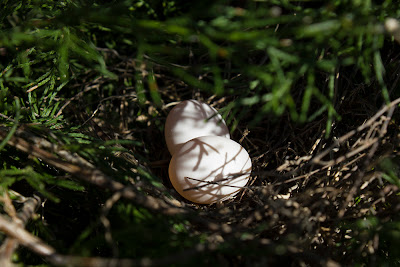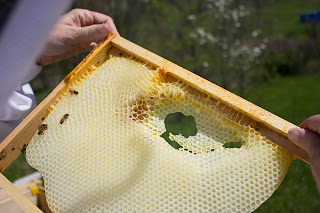May 1st I did a complete hive inspection of our remaining hive with Lily assisting. I had seen a lot of mouse poop in the sugar we fed in February and feared there was a mouse nest in the bottom box, so I knew we'd have to do a complete inspection top to bottom to clean out whatever was in the bottom.
Also, now's the time to do splits, so I was planning on taking at least a nuc's worth off and hopefully splitting two nucs worth off.
There were a lot of bees in the top box, so I just took the whole box off and set it aside on a spare SBB [screen bottom board.] between the Tardis and the lang.
In the bottom box there was a lot of evident mouse damage. You can see how the mouse started on one side and ate the honey through center to the wax capping on the far side. Smart, but seriously aggravating.
This is what I found in the bottom of the box. A whole lot of wax cappings, dead bee parts, mouse droppings and other debris.
But no nest! The mouse must have had a nest elsewhere and just come in from the top regularly to feast. The debris was a couple of inches deep on the bottom. I cleaned it all out.
I went through every frame in the bottom box and there was no brood at all. I knew then that I wouldn't be getting more than one nuc's worth of split, but since we're down to only one hive, I figured that was better than nothing.
I left one frame of honey on the south end and left the rest of the frames out. I'd be replacing them with the split.
The other box was full of bees. I decided to do an even split and a walkaway.
A walkaway is where you take some of the bees out and put them in a new hive and leave them alone to make a new queen.
An even split is where you take the frames and deal them like cards - one frame for the old hive, one for the new hive, etc.

There were five frames full of capped brood, larvae and eggs. I could see where the first brood had emerged already and those spaces were full of larvae again. Good queen!
Click the pics for closeups of the larvae.
Here's a close-up of the eggs. They look like grains of rice in the bottoms of the cells. The cells are yellow because the bees are tracking pollen all over everything right now.

We did sight the queen - and she's gorgeous. Very calm.
We ended up putting her in the Tardis with two frames of brood.The other three frames of brood I left in the lang.
I made a couple of mistakes that you can learn from.
1. Lots of beeks talk about checkerboarding - where you put an empty frame between the drawn or full stuff to encourage the bees to expand the hive. I did that with the brood - put empty drawn comb between the brood frames.
MISTAKE: You want the brood in a tight cluster because it's easier for the bees to keep it warm. I just split the hive, so there are many fewer bees to keep the brood warm and this is Indiana - no telling what the weather is going to do for the next few weeks.
Checkerboarding is fine for honey supers, but not for brood. I went back in a few hours later and took the empties out and tucked the brood frames next to each other. I thank Michael Bush's book for making this clear to me [The Practical Beekeeper - link on my sidebar] Having that book handy is like having a 24/7 mentor.
2. I put the queen and two frames of brood in the Tardis, with 7 more frames of honey and partials and the follower board.
 |
| Pollen that fell out of some cells during the move |
MISTAKE: The Tardis is in a different place - all of the field bees are going to
come back to the lang, which will leave a lot of bees with the 3 frames
of brood in the lang, but will leave the Tardis short handed. Short handed for keeping the brood warm in a big box.
I went in the next morning to see how much action there was in the Tardis and while the brood was well covered, there just weren't a lot of bees coming and going, so I quickly went back in and removed 4 frames. Now they have a frame of honey, 2 frames of brood, then 3 more frames of honey and partials - 6 in all, then I put in the follower board to make it a much smaller space to keep warm. [A follower board is a removable wooden wall in the shape of a frame that you use to make the space smaller or bigger as you need to.]

I figure that the two hives are now on roughly equal footing for different reasons.
The lang has no queen, but they have three frames of brood in various stages, plus eggs, plus all the extra field bees.
They were super busy coming and going the next day and I think they'll do fine.
I'll keep an eye on things and after three weeks I'll go in and make sure they've got queen cells.
The Tardis has fewer bees and only two frames of brood, but she has the queen. And she's a good queen. I'm hoping that will make up for it.
Also, the Tardis has a window at the back so I can easily monitor the numbers. If I need to shake a few extra bees into the hive from the lang, I can.

When I was all done, I put the rest of the bee candy on the tops of the frames in both hives and put supers around them, then put rocks on the landing board in front of the Tardis entrance so they'd have to go around them to exit and enter. They'll re-orient. Also those bees were fanning like crazy during the relocation [pic], so I think any bees that moved with the queen will stick with her.
Fingers crossed everything will be fine and they'll be ready for the main flow in a few weeks.

 I don't like celery much by itself, but I like it in soup stock. We buy a few bunches every year, then cut them up into little chunks and dehydrate them. Then they go in bags in the freezer so we can grab a handful at a time to toss into soup stock. Mmm.
I don't like celery much by itself, but I like it in soup stock. We buy a few bunches every year, then cut them up into little chunks and dehydrate them. Then they go in bags in the freezer so we can grab a handful at a time to toss into soup stock. Mmm.




















































